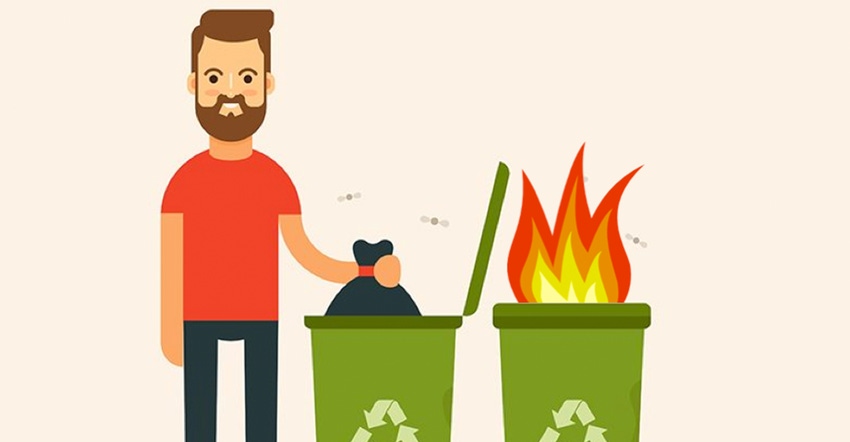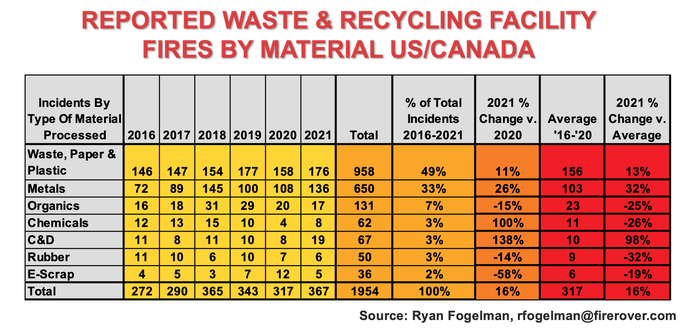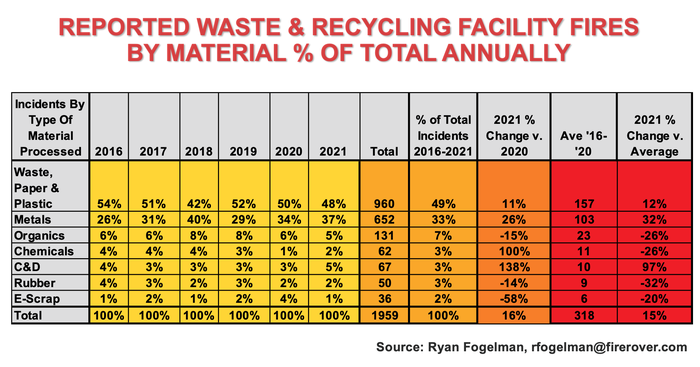
2021 is in the books, and I am hard at work on the “5th Annual Waste & Recycling Facility Fires Annual Report for the US and Canada.” This year’s report promises to be one for the ages as we officially experienced more reported fire incidents this year than we have since I began consolidating the data in 2016.
When I began down this road, we were all asking the question of “what” is causing these fire incidents. From most of my analysis, as well as other reports in the industry, I believe we have the “what” figured out. Traditional hazards along with the continuing increase in lithium-ion batteries in our waste and recycling streams are well established and recognized as the cause. Although these hazards do not explain all the fires we see in the different lines of business, the industry has been moving toward the “how” are we going to best deal with these issues, whether it be training, education, technology, policies or drastic changes in the supply chain.
This month, I provide you with December’s data as well as a preview of 2021’s data, which will be further highlighted in my annual report.Click here to reserve your advanced copy of this year’s annual waste and recycling facility fires report.
December 2021 Fire Data
Before we get into the overall 2021 data, let’s first look at December’s numbers. Last month, we encountered 29 reported fire incidents at our waste and recycling facilities in the U.S. and Canada. This marks the worst month for fires in December since 2016. Of these reported incidents, scrap metal facilities topped the list for the second month in a row with 13 incidents. Additionally, 13 occurred at waste, paper and plastic operations, one occurred at a construction and demolition (C&D) operation, one occurred at an organics site and one occurred at a rubber facility. At Fire Rover’s 300-plus client operations, we responded to 82 fire incidents in December to go along with the 72 fire incidents in November, 71 in October, 69 in September, 92 in August, 88 in July, 77 in June, 88 in May and 74 in April.

2021 Fire Data
I wish there was a silver lining to last year’s results, but 2021 was the worst year for publicly reported fire incidents at waste and recycling facilities in the U.S. and Canada since 2016. We experienced 367 reported fires in 2021, topping the global “lithium-ion battery wave” that hit us hard in 2018.
 So, how do we make sense of that number from a historical perspective? During 2018, we had very limited data and a minimal understanding of the problem. Now, with three more years of data, we have a better understanding of the problem and are in a much different place than we were in 2018. Today, it is well established that there is an inherent risk of fires in our waste and recycling streams. The scariest part of this data is not one of these fires occurred at any of the 300 facilities equipped with our Fire Rover system. That is not to say there were not fires at our clients’ sites, but only one got to the point of being reported and it did not start in an area that we protect. Additionally, publicly reported incidents are normally 2 alarm or more which makes it newsworthy.
So, how do we make sense of that number from a historical perspective? During 2018, we had very limited data and a minimal understanding of the problem. Now, with three more years of data, we have a better understanding of the problem and are in a much different place than we were in 2018. Today, it is well established that there is an inherent risk of fires in our waste and recycling streams. The scariest part of this data is not one of these fires occurred at any of the 300 facilities equipped with our Fire Rover system. That is not to say there were not fires at our clients’ sites, but only one got to the point of being reported and it did not start in an area that we protect. Additionally, publicly reported incidents are normally 2 alarm or more which makes it newsworthy.
A potential hypothesis that we must look at as well is the “pandemic effect.” We all know that 2020 was far from a normal year for most aspects of our lives. We were under stay-at-home orders, we were following social distancing requirements on our sorting lines and we were experiencing a monumental shift in our waste and recycling streams from commercial to residential. Just as we experienced a decrease in fire incidents in 2020, that material tonnage could have shifted from 2020 into 2021. This would make sense as a significant number of fire incidences occurred in the first half of 2021.
 Now, let’s look at some of the data from 2021. To understand the numbers, I think it is best to look at percentages. As you can see from the graph, we saw more than a 10 percent increase in waste, paper and plastic fires from 2020 as well as from the average number of fires from 2016-2020. Both metal and construction and demolition (C&D) operations also saw a significant increase from last year and historical norms in 2021, rising more than 30 percent and more than 100 percent, respectively.
Now, let’s look at some of the data from 2021. To understand the numbers, I think it is best to look at percentages. As you can see from the graph, we saw more than a 10 percent increase in waste, paper and plastic fires from 2020 as well as from the average number of fires from 2016-2020. Both metal and construction and demolition (C&D) operations also saw a significant increase from last year and historical norms in 2021, rising more than 30 percent and more than 100 percent, respectively.
 To show a different perspective, I have broken out the percentage change each year to take the number of incident bias out of the equation. Here, we see that the waste, paper and plastic numbers are in line with historical norms with 11 percent over 2020 and 12 percent over the historical average. Metals fire incidents, on the other hand, are up 26 percent from 2020 and 32 percent from the historical average. Chemical fire (hazmat) incidents were double over 2020 but in line with the historical average, and C&D incidents were more than double over 2020 and almost double the historical average.
To show a different perspective, I have broken out the percentage change each year to take the number of incident bias out of the equation. Here, we see that the waste, paper and plastic numbers are in line with historical norms with 11 percent over 2020 and 12 percent over the historical average. Metals fire incidents, on the other hand, are up 26 percent from 2020 and 32 percent from the historical average. Chemical fire (hazmat) incidents were double over 2020 but in line with the historical average, and C&D incidents were more than double over 2020 and almost double the historical average.
Injuries & Deaths
It’s no secret that our industry is one of the most dangerous occupations. So, when we look at percentage versus actual fire events, the one thing we cannot hide from is the number of injuries and deaths that have occurred due to fires at our waste and recycling facilities. I can assure all who read this that I am not bringing up injuries and deaths to try and give the industry a black eye, which it doesn’t need or deserve. The waste and recycling industry is critical to our society, and we need to help protect our employees’ safety at all costs.

So, each year, I share this compiled data for a few reasons. First, to show that fighting fires is dangerous and should only be left to the trained professionals who fight fires daily. Second, to show that most of these injuries are to fire professionals, not employees. Therefore, if you’re going to ask your employees to be on the frontlines, you need to provide them with the equipment (CAFS, hoses, alarm stations, etc.) and training to fight fires from a safe distance. This will help reduce the number of major fires and injuries, as fewer firefighters will need to be on the scene.
Additionally, extended producer responsibility can help with this issue. Most of the hazards and harm from lithium-ion batteries unfairly fall to the waste and recycling operators and the fire professionals who fight these fires on an almost daily basis. Therefore, they need the right training, tools and technology to do their jobs, and it is only fair that those who are responsible share the cost of the problems they create.
Conclusion
The information shared so far is only the tip of the iceberg. I am hard at work getting my data and analysis ready for my upcoming annual report, which I hope you find valuable. My promise is to have this year’s annual report published in February before I head to the Global Waste Management Symposium (GWMS), held February 14-17 in Palm Springs, Calif., where I will be presenting my findings as part of the recycling track on Wednesday, February 16 at 1:30 p.m. PT. Click here to learn more about the event and to register. I hope your 2022 is off to a great start!
Ryan Fogelman, JD/MBA, is vice president of strategic partnerships for Fire Rover. He is focused on bringing innovative safety solutions to market, and two of his solutions have won the distinguished Edison Innovation Award for Industrial Safety and Consumer Products. He has been compiling and publishing the “Reported Waste & Recycling Facility Fires In The US/CAN” since February 2016 and the “Waste & Recycling Facility Fires Annual Report.” Fogelman speaks regularly on the topic of the scope of fire problems facing the waste and recycling industries, detection solutions, proper fire planning and early-stage fire risk mitigation. Additionally, Fogelman is on the National Fire Protection Association’s Technical Committee for Hazard Materials. (Connect with Ryan on LinkedIn at https://www.linkedin.com/in/ryanjayfogelman or email at [email protected])
About the Author(s)
You May Also Like




